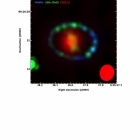Supernova 1987A at 26.6 Years
Supernova 1987A (SN1987A) in the Large Magellanic Cloud is the brightest supernova to be observed since SN1604 (Kepler). Observations taken with almost every type of telescope, on the ground and in space, have yielded a rich story of the evolution of the explosion debris and its interaction with its circumstellar environment. Recent observations of SN1987A with the incomplete ALMA array have given us an unprecedented view of the cold inner debris, which contains surprisingly large masses of dust grains and CO and SiO molecules. The 1.30 mm emission line from the CO 2-1 transition and the 1.38 mm emission line from the SiO 5-4 transition are sufficiently bright that we will be able to obtain 3-dimensional images of the distribution of these molecules in the supernova debris when the full ALMA array becomes available.

